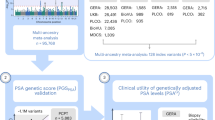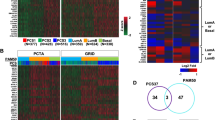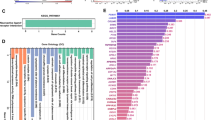Summary
KLK3 or prostate specific antigen (PSA) is a serine protease, which is an established tumour marker of prostatic adenocarcinoma. PSA is now used widely for the diagnosis and monitoring of patients with prostate cancer. Recent studies have demonstrated that about 70% of breast cancers produce PSA. In this study, we examined the molecular mechanism underlying the expression of the PSA gene in breast cancer and breast cancer cell lines. We analysed nine breast tumours categorized on the basis of high- or low-PSA expression in tumour cytosols and four breast cancer cell lines. To determine abnormalities associated with PSA expression in breast tumours, genomic DNA was extracted and all five exons of the PSA gene were polymerase chain reaction (PCR) amplified and sequenced on both strands. PCR amplification was also performed for the promoter and enhancer elements of the PSA gene. No mutations were observed in the coding portion of the gene. A polymorphism was observed in exon 2 from three breast tumours. However, sequencing of the promoter and the enhancer elements of the PSA gene reveals several point mutations. Within a 5.8-kb promoter/enhancer region of the PSA gene, we detected 16 different mutational hotspots (appearing more than once in the nine tumours). Among these hotspots, two appeared in seven out of nine tumours. Most importantly, the androgen response element (ARE I) in the proximal promoter was found mutated in four tumours and in the breast carcinoma cell line MCF-7. Mutations associated with the ARE I have been shown previously to result in an 80% decrease in PSA gene expression. The mutations in the core enhancer and promoter region probably contribute to the aberrant expression of the PSA gene in breast tumours, possibly by altering the regulation of the gene by steroid hormones.
Similar content being viewed by others
Article PDF
Change history
16 November 2011
This paper was modified 12 months after initial publication to switch to Creative Commons licence terms, as noted at publication
References
Ahe, D., Janich, S., Scheidereit, C., Renkawitz, R., Schutz, G. & Beato, M. (1985). Glucocorticoid and progesterone receptors bind to the same sites in two hormonally regulated promoters. Nature 313: 706–709.
Cairns, C., Gustafsson, J-A & Carlstedt-Duke, J. (1991). Identification of protein contact sites within the glucocorticoid/progestin response element. Mol Endocrinol 5: 598–604.
Catalona, W. J., Smith, D. S., Ratliff, T. L., Dodds, K. M., Caplen, D. E., Yuan, J. J., Petros, J. A. & Andriole, G. L. (1991). Measurement of prostate-specific antigen in serum as a screening test for prostate cancer. N Engl J Med 324: 1156–1161.
Cleutjens, K.B.J.M., van der Korput, H.A.G.M., van Eekelen, C.C.E.M., van Rooij, H. C. J., Faber, P. W. & Trapman, J. (1997). An androgen response element in a far upstream enhancer region is essential for high, androgen-regulated activity of the prostate-specific antigen promoter. Mol Endocrinol 11: 148–161.
Digby, M., Zhang, X-Y & Richards, R. I. (1989). Human prostate specific antigen (PSA) gene: structure and linkage to the kallikrein-like gene, hGK-1. Nucleic Acids Res 17: 2137
Ferguson, R. A., Yu, H., Kalyvas, M., Zammit, S. & Diamandis, E. P. (1996). Ultrasensitive detection of prostate specific antigen by time-resolved immunofluorometric assay and the immulite immunochemiluminescent third generation assay: potential applications in prostate and breast cancers. Clin Chem 42: 536–544.
Graff, J. R., Herman, J. G., Lapidus, R. G., Chopra, H., Xu, R., Jarrad, D. F., Isaacs, W. B., Pitha, P. M., Davidson, N. E. & Baylin, S. B. (1995). E-cadherin expression is silenced by DNA hypermethylation in human breast and prostate carcinomas. Cancer Res 55: 5195–5199.
Henntu, P., Liao, S. & Vikho, P. (1992). Androgens upregulate the human prostate specific antigen messenger ribonucleic acid, but down-regulate the prostatic phosphatase mRNA in LNCaP cells. Endocrinology 130: 766–772.
Levesque, M., Yu, H., D’Costa, M. & Diamandis, E. P. (1995). Prostate specific antigen expression by various tumors. J Clin Lab Anal 9: 123–128.
Lilja, H. (1985). A kallikrein like serine protease in prostatic fluid cleaves the predominant seminal vesicle protein. J Clin Invest 76: 1899–1903.
Lundwall, A. (1989). Characterization of the gene for prostate specific antigen, a human glandular kallikrein. Biochem Biophys Res Commun 161: 1151–1159.
McCormak, R. T., Rittenhouse, H. G., Finlay, J. A., Sokoloff, R. L., Wang, T. J., Wolfert, R. L., Lilja, H. & Oesterling, J. E. (1995). Molecular forms of prostate-specific antigen and the human kallikrein gene family: a new era. Urology 45: 729–744.
MacDonald, R. J., Margolius, H. S. & Erdos, E. G. (1988). Molecular biology of tissue kallikrein. Biochem J 253: 313–321.
Maniatis, T., Fritsch, E. F. & Sambrook, J. (1982). Molecular Cloning: A Laboratory Manual, Cold Spring Harbor Laboratory Press: Cold Spring Harbor, NY
Oesterling, J. E. (1991). Prostate specific antigen: a critical assessment of the most useful tumor marker for adenocarcinoma of the prostate. J Urol 145: 907–923.
Ottaviano, Y. L., Issa, J. P., Parl, F. F., Smith, H. S., Baylin, S. B. & Davidson, N. E. (1994). Methylation of the estrogen receptor gene CpG island marks loss of estrogen receptor expression in human breast cancer cells. Cancer Res 54: 2552–2555.
Pisani, P., Parkin, D. M. & Ferlay, J. (1985). Estimates of the worldwide mortality from eighteen major cancers in 1985: implications for prevention and projections of future burden. Int J Cancer 55: 891–903.
Riegman, P. H. J., Vlietstra, R. J., van der Korput, J.A.G.M., Romijn, J. C. & Trapman, J. (1989). Characterization of the prostate specific antigen gene: a novel human kallikrein-like gene. Biochem Biophys Res Commun 159: 95–102.
Riegman, P. H. J., Vliestra, R. J., Korput, J.A.G.M., Romijn, J. C. & Trapman, J. (1991). Identification and androgen regulated expression of two major human glandular kallikrein-1 (hGK-1) mRNA species. Mol Cell Endocrinol 76: 181–190.
Riegman, P. H. J., Vlietstra, R. J., Suurmeijer, L., Cleutjens, C.B.J.M. & Trapman, J. (1992). Characterization of the human kallikrein locus. Genomics 14: 6–11.
Sauter, E. R., Daly, M., Lenahan, K., Ehya, H., Engstrom, P. F., Sorling, A., Bonney, G., Yu, H. & Diamandis, E. P. (1996). Prostate-specific antigen levels in nipple aspirate fluid correlate with breast cancer risk. Cancer Epidemiol Biomarkers Prev 5: 967–970.
Schedlich, L. J., Bennetts, B. H. & Morris, B. J. (1987). Primary structure of a human glandular kallikrein gene. DNA 6: 429–437.
Schulz, P., Stucka, R., Feldmann, H., Combriato, G., Klobeck, H-G & Fittler, F. (1988). Sequence of a cDNA clone encompassing the complete mature human prostate specific antigen (PSA) and an unspliced leader sequence. Nucleic Acids Res 16: 6226
Schuur, E. R., Henderson, G. A., Kmetec, L. A., Miller, J. D., Lamparski, H. G. & Henderson, D. R. (1996). Prostate-specific antigen expression is regulated by an upstream enhancer. J Biol Chem 271: 7043–7051.
Smith, M. N. R., Biggar, S. & Hussain, M. (1995). Prostate specific antigen messenger RNA is expressed in non-prostate cells: implications for detection of micrometastases. Cancer Res 55: 2640–2644.
Stamey, T. A., Yang, N., Hay, A. R., McNeal, J. E., Freiha, F. S. & Redwine, E. (1987). Prostate specific antigen as a serum marker for adenocarcinoma of the prostate. N Engl J Med 317: 909–916.
Truss, M. & Beato, M. (1993). Steroid hormone receptors: interaction with deoxyribonucleic acid and transcription factors. Endocrinol Rev 14: 459–479.
Tsuyuki, D., Grass, L. & Diamandis, E. P. (1997). Frequent detection of mutations in the 5′ flanking region of the prostate specific antigen gene in female breast cancer. Eur J Cancer 33: 1853–1856.
Watt, K. W., Lee, P. J. L., M’Timkulu, T., Chan, W. P. & Loor, R. (1986). Human prostate-specific antigen: structural and functional similarity with serine protease. Proc Natl Acad Sci USA 83: 3166–3170.
Yoshiura, K., Kanai, Y., Ochiai, A., Shimoyama, Y., Sugimura, T. & Hirohashi, S. (1995). Silencing of the E-cadherin invasion-suppressor gene by CpG methylation in human carcinomas. Proc Natl Acad Sci USA 92: 7416–7419.
Young, C. Y. F., Andrews, P. E., Montgomery, B. T. & Tindall, D. J. (1992). Tissue specific and hormonal regulation of human prostate-specific glandular kallikrein. Biochemistry 31: 818–824.
Yu, H., Diamandis, E. P., Zarghami, N. & Grass, L. (1994). Induction of prostate specific antigen production by steroid and tamoxifen in breast cancer cell lines. Breast Cancer Res Treat 32: 291–300.
Yu, H., Diamandis, E. P., Katsaros, D., Sutherland, D. J. A., Levesque, M. A., Roagna, R., Ponzone, R. & Sismondi, P. (1995). Prostate-specific antigen is a new favorable prognostic indicator for women with breast cancer. Cancer Res 55: 2104–2110.
Yu, H., Diamandis, E. P., Levesque, M., Asa, S. L., Monne, M. & Croce, C. M. (1995). Expression of the prostate specific gene by a primary ovarian carcinoma. Cancer Res 55: 1603–1606.
Zarghami, N., Grass, L. & Diamandis, E. P. (1997). Steroid hormone regulation of prostate specific antigen gene expression in breast cancer. Br J Cancer 33: 579–588.
Author information
Authors and Affiliations
Rights and permissions
From twelve months after its original publication, this work is licensed under the Creative Commons Attribution-NonCommercial-Share Alike 3.0 Unported License. To view a copy of this license, visit http://creativecommons.org/licenses/by-nc-sa/3.0/
About this article
Cite this article
Majumdar, S., Diamandis, E. The promoter and the enhancer region of the KLK 3 (prostate specific antigen) gene is frequently mutated in breast tumours and in breast carcinoma cell lines. Br J Cancer 79, 1594–1602 (1999). https://doi.org/10.1038/sj.bjc.6690254
Received:
Accepted:
Published:
Issue date:
DOI: https://doi.org/10.1038/sj.bjc.6690254
Keywords
This article is cited by
-
Synthetic CRISPR/dCas9-KRAB system driven by specific PSA promoter suppresses malignant biological behavior of prostate cancer cells through negative feedback inhibition of PSA expression
Cellular & Molecular Biology Letters (2023)
-
TARP as antigen in cancer immunotherapy
Cancer Immunology, Immunotherapy (2021)
-
Transcriptional upregulation of human tissue kallikrein 6 in ovarian cancer: clinical and mechanistic aspects
British Journal of Cancer (2007)
-
Serum PSA levels are not affected by the menstrual cycle or the menopause, but are increased in subjects with polycystic ovary syndrome
Journal of Endocrinological Investigation (2006)
-
The emerging roles of human tissue kallikreins in cancer
Nature Reviews Cancer (2004)



